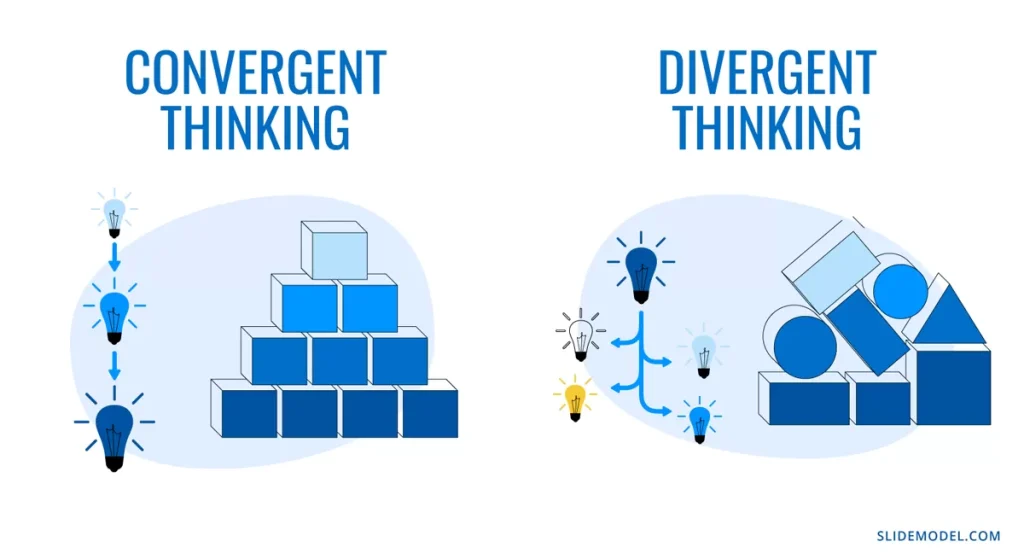
We practice computational thinking in many of my coding classes. Computational thinking is both a way of thinking and a creative problem-solving strategy. An important part of the process is using divergent thinking to generate “ideas” for the more difficult parts of a problem. Generating ideas is very different than finding answers. Many of my students are good at finding answers when they have previous experience with the problem. What many of them struggle with is generating ideas. Ideas are possibilities to be explored. We don’t always know if they are going to work or not. Students have a lot of trouble considering possibilities when there is not a clear answer from the start.
Why Divergent Thinking Matters
In today’s world, the ability to generate new ideas and consider multiple possibilities is becoming increasingly valuable. Divergent thinking helps students break free from the confines of finding “the right answer” and opens up a whole new realm of creative problem-solving. It’s this kind of thinking that powers innovation and helps us navigate complex, unfamiliar situations—whether in coding, business, or even everyday life.
But divergent thinking isn’t just for adults or professionals. It’s an essential skill for children to learn early on. Why? Because the world is changing rapidly, and they need to be prepared for challenges that don’t have a clear solution. By encouraging children to think divergently, we’re equipping them with the tools to approach problems with curiosity, creativity, and flexibility.
Helping Kids Explore Possibilities
Many kids, like the students in my coding classes, are accustomed to finding answers based on past experience. When presented with a problem they’ve seen before, they can often recall the solution and apply it. However, when faced with something new or ambiguous, they can struggle. That’s because generating ideas isn’t about knowing—it’s about exploring possibilities. It’s about asking “What if?” and seeing where that question takes you, even if you don’t have an immediate solution.
Divergent thinking encourages children to step outside of the familiar, to let go of the need for a “correct” answer, and to experiment with ideas. In coding, for instance, students might generate a dozen ways to approach a challenging algorithm, even though they’re unsure which one will work. This experimentation is key because it allows them to learn through exploration, failure, and iteration—an essential mindset for both coding and life.
Why Parents Should Encourage Divergent Thinking
While schools often emphasize convergent thinking—finding the single right answer—parents can help foster divergent thinking at home. Encouraging children to develop this skill will not only make them more creative and adaptable but will also build their resilience. When kids are comfortable exploring possibilities without needing immediate success, they become less afraid of failure. They start to view mistakes as opportunities for growth rather than as dead ends.
Divergent thinking also enhances a child’s problem-solving skills. Instead of sticking with one tried-and-true method, they can approach challenges from multiple angles. This flexibility is invaluable in today’s fast-paced world, where problems are rarely black and white and often require out-of-the-box solutions.
How Parents Can Support Divergent Thinking at Home
Foster Curiosity Through Open-Ended Play
- Allow your child the space for unstructured, open-ended play. This could involve building with blocks, inventing stories with dolls or action figures, or creating art. The key is to let them decide how they play, without directing them towards a specific goal. The absence of a clear endpoint encourages divergent thinking, as they explore possibilities and imagine different outcomes.
Ask “What If?” Questions
- Help your child develop the habit of considering multiple possibilities by asking “what if?” questions. For example, “What if we designed this game differently?” or “How many ways could we build this tower?” These questions push kids to think creatively, without needing to land on a final answer right away.
Value Ideas Over Results
- Celebrate ideas, even if they don’t always work out. When children come up with a solution that doesn’t solve the problem, praise their effort and creativity. This encourages them to keep generating ideas without the fear of failure holding them back.
Encourage Risk-Taking
- Help your child become comfortable with risk-taking. In coding, for instance, trying different approaches, even if they don’t always work, is how we eventually find solutions. The same is true in life. Encourage them to try new things, experiment, and take risks, reminding them that not every idea needs to be perfect.
Limit Overly Structured Activities
- Too many structured activities can limit a child’s ability to think divergently. While routine is important, make sure there’s also time for unstructured, creative exploration. Give them opportunities to try new activities without set instructions or predetermined outcomes.
The Long-Term Benefits of Divergent Thinking
Divergent thinking is not just a tool for creativity; it’s a mindset that will benefit children in all areas of life. It teaches them to approach challenges with curiosity and open-mindedness. It helps them become more flexible, adaptable, and resilient. And in a world where many problems don’t have a clear solution from the start, these are the qualities that will set them apart.
As I’ve seen in my coding classes, learning to generate ideas and explore possibilities is a skill that can be developed with practice. By nurturing divergent thinking at home, parents can help their children become more confident problem-solvers who are ready to take on whatever challenges the future may bring.
Looking for More Ways to Help Your Child Prepare For The Future?
STEM Project Using Roblox Studio: (Ages 8-14)
Creative Problem Solving For Kids: SCAMPER
Creative Problem Solving For Kids: Random Words
Creative Problem Solving For Kids: Copy Nature
5 Ways to Improve Your Child’s Communication Skills
Teaching Kids The Value of Mistakes
Encouraging Productive Struggle: A Guide For Parents
Developing Your Child’s Self-Directed Learning Skills
Helping Your Child Master the Art of Brainstorming
SCAMPER + AI: Helping Kids Use AI Tools to Spark Better Ideas

Comments on this entry are closed.